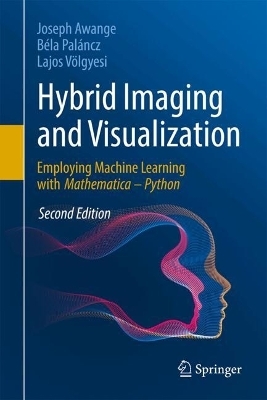
Hybrid Imaging and Visualization
Springer International Publishing (Verlag)
9783031728167 (ISBN)
This second edition of the book that targets those in computer algebra and artificial intelligence introduces Black Hole algorithm that is essential for optimizing hyperparameters, an important task in machine learning where mostly, stochastic global methods are used as well as ChatGPT, a novel and in the last few years, very popular Generative AI technology. In addition, fisher discriminant, a linear discriminant that can provide an optimal separation of objects, and the conversion of time series into images thereby making it possible to employ convolution neural network to classify time series effectively are presented.
Professor Joseph Awange joined the Department of Spatial Sciences (Curtin University, Australia) in 2006 under a Curtin Research Fellowship and concurrently undertook the prestigious Alexander von Humboldt (AvH) Fellowship at the Geodetic Institute (Karlsruhe Institute of Technology, Germany) having been awarded the Australian 2008-2011 Ludwig Leichhardt Memorial Fellowship for experienced researchers. In 2015, he won all the three major Fellowship Awards: Alexander von Humboldt (Germany), Japan Society of Promotion of Science (Japan) and Brazil Frontier of Science (Brazil) to carry out research in those countries. At Curtin University, he is currently engaged in teaching and research having attracted more than $1.5M worth of research grants. He obtained his BSc and MSc degrees in Surveying from the University of Nairobi (Kenya), and was also awarded a merit scholarship by the German Academic Exchange Program (DAAD), which facilitated his obtaining a second MSc degree and PhD in Geodesy at Stuttgart University (Germany). In 2002-2004, he was awarded the prestigious Japan Society for Promotion of Science (JSPS) Fellowship to pursue postdoctoral research at Kyoto University (Japan). Prof Awange attained International Editorial role in Springer Earth Science Books and has authored 11 scholarly books with the prestigious Springer publishers and more than 130 peer-reviewed high impact journal publications (in e,g., Remote Sensing of Environment, Journal of Climate, Climatic Change, Advances in Water Resources, International Journal of Climatology, and Journal of Hydrology among others).
Béla Paláncz is emeritus professor of computer science at the Technical University of Budapest, Hungary. He received his D.Sc. from the Hungarian Academy of Sciences in 1993 and has a background in education and research of mathematical modeling and numeric-symbolic computation as well as machine learning algorithms and experience abroad including at RWTH (Aachen, Germany), Imperial College (London), and Wolfram Research (USA), Research Institute for Symbolic Computation (RISC) Johannes Kepler University ( Linz, Austria) and recently Curtin University, School of Earth and Planetary Sciences (Perth, Australia) and University of Canterbury, Department of Mechanical Engineering (Christchurch, New Zealand). He can be contacted at the Department of Geodesy and Surveying, Faculty of Civil Engineering, Budapest University of Technology and Economics, H-1111 Budapest, M egyetem rkp.3., Hungary.
Lajos Völgyesi graduated as a geophysicist from the Faculty of Natural Sciences of Eötvös Loránd University in Budapest. Currently, he is Professor Emeritus at the Department of Geodesy and Surveying of the Faculty of Civil Engineering of the Budapest University of Technology and Economics. He is a member of the Hungarian Academy of Sciences. His main research interests are in the fields of physical and theoretical geodesy, mathematical geosciences and geophysics. He has significant scientific achievements in the fields of time variation of the geoid and the explanation of the physical background of major geoid anomalies, the geophysical foundations of 4-dimensional geodesy and the study of Earth rotation phenomena. He also does researches in astronomical geodesy and, together with his physicist colleagues, has started an important series of experiments to prove the so-called weak equivalence principle by remeasuring the Eötvös experiment. His research results have been published in about 200 papers and numerous international presentations and scientific conferences. He has authored and co-authored several textbooks, including two award of excellence for his textbook Geophysics.
Chapter 1. Dimension Reduction.- Chapter 2. Classification.- Chapter 3. Clustering.- Chapter 4. Regression.- Chapter 5. Neural Networks.- Chapter 6. Optimizing Hyperparameters.- Chapter 7. ChatGPT.
| Erscheinungsdatum | 13.05.2025 |
|---|---|
| Zusatzinfo | XXIII, 450 p. 554 illus., 481 illus. in color. |
| Verlagsort | Cham |
| Sprache | englisch |
| Maße | 155 x 235 mm |
| Themenwelt | Informatik ► Grafik / Design ► Digitale Bildverarbeitung |
| Naturwissenschaften ► Geowissenschaften ► Geografie / Kartografie | |
| Naturwissenschaften ► Geowissenschaften ► Geophysik | |
| Schlagworte | Computational algorithms for visualization • computer vision • Convolution Neural Networks • Data Visualization • Hybrid Imaging • Hybrid symbolic-numeric computations • Hybrid visualization • Image Compression • Image Recognition • Laser scanning • Photogrammetry • Remote Sensing/Photogrammetry • Restoration images • symbolic-numeric computation |
| ISBN-13 | 9783031728167 / 9783031728167 |
| Zustand | Neuware |
| Informationen gemäß Produktsicherheitsverordnung (GPSR) | |
| Haben Sie eine Frage zum Produkt? |
aus dem Bereich


